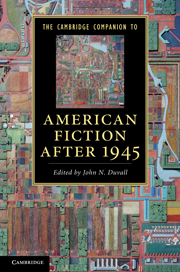Book contents
- Frontmatter
- Introduction: A story of the stories of American fiction after 1945
- PART I POETICS AND GENRES
- PART II HISTORICAL AND CULTURAL CONTEXTS
- 6 African American fiction
- 7 American Indian fiction
- 8 Multiethnicities: Latino/a and Asian American fiction
- 9 American Jewish Fiction
- 10 Feminist fiction
- 11 Southern fiction
- 12 Fiction and the Cold War
- 13 Fiction and 9/11
- PART III MAJOR AUTHORS
- Conclusion: Whither American fiction?
- Index
- Cambridge Companions to …
8 - Multiethnicities: Latino/a and Asian American fiction
from PART II - HISTORICAL AND CULTURAL CONTEXTS
Published online by Cambridge University Press: 28 March 2012
- Frontmatter
- Introduction: A story of the stories of American fiction after 1945
- PART I POETICS AND GENRES
- PART II HISTORICAL AND CULTURAL CONTEXTS
- 6 African American fiction
- 7 American Indian fiction
- 8 Multiethnicities: Latino/a and Asian American fiction
- 9 American Jewish Fiction
- 10 Feminist fiction
- 11 Southern fiction
- 12 Fiction and the Cold War
- 13 Fiction and 9/11
- PART III MAJOR AUTHORS
- Conclusion: Whither American fiction?
- Index
- Cambridge Companions to …
Summary
Throughout the years following World War II (and particularly since the 1960s), there have been spectacular advances in the quantity and influence of multicultural American authorship. Just as Latino/a and Asian American populations have grown increasingly prominent in the United States, so a plenitude of new literary fiction – novel and novella, story and story cycle – has emerged to match and indeed engender a rethinking of what “ethnic” and allied notions actually signify. This, to be sure, includes reaffirmation and continuance of the Latino/a literary spectrum, the Chicanismo signaled in the fiction of Tomás Rivera, Rudolfo Anaya, and Rolando Hinojosa, and a women's generation to include Sandra Cisneros and Ana Castillo, together with the rosters of new storytelling by Riqueños/as, Cuban Americans, Dominican Americans, and others whose origins in the Latin and Caribbean Americas give a hemispheric reach to Hispanic voice. An awakened Asian American literary consciousness equally invites its due; narratives that severally but always uniquely pursue American lives filtered through China, Japan, Korea, Vietnam, the Philippines, and Indo-Pakistan and other South Asian countries, by such writers as Maxine Hong Kingston, Toshio Mori, Theresa Hak Kyung Cha, Lan Cao, Jessica Hagedorn, and Bharati Mukherjee.
- Type
- Chapter
- Information
- The Cambridge Companion to American Fiction after 1945 , pp. 114 - 128Publisher: Cambridge University PressPrint publication year: 2011



